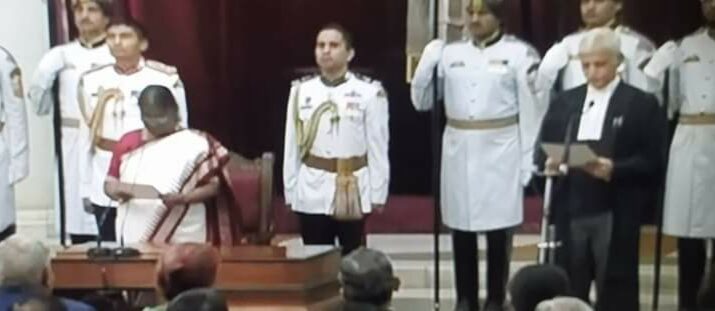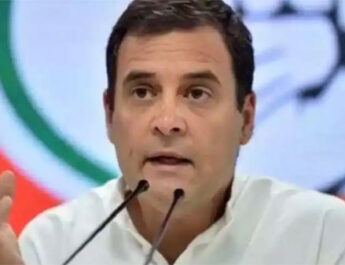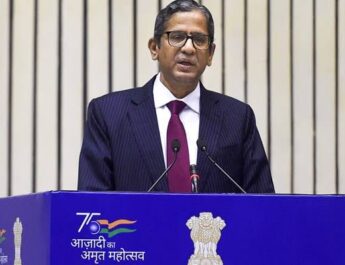From Our Bureau
NEW DELHI: President Droupadi Murmu on Saturday administered the oath of office to Justice Uday Umesh Lalit as the 49th Chief Justice of India. His tenure will be short for only 74 days as he retires on November 8 on completing 65 years of age.
Because of the swearing-in at the Rashtrapati Bhawan, it said: “The change of guard ceremony will not be held this Saturday on the forecourt of Rashtrapati Bhawan due to the swearing-in ceremony of the Chief Justice of India.” The change of guard slated on July 23 was also postponed due to the full dress rehearsal of the asumption of office by President Murmu. A coincidence that Murmu had taken the oath in front of former CJI N V Ramana, who retired on Friday, on July 25.
Justice Lalit was involved in handling some landmark judgments in Triple Talaq case and sentencing of liquor king and former MP Vijay Mallya to four months of jail in 2017. During his short tenure as the CJI, he will be presiding over some of the Constitutional Bench cases pending for long. In fact, he starts his CJI career on Monday with 25 Constitutional cases to be listed before the Apex Court.
Justice Lalit is the second CJI directly elevated to the Supreme Court from the Bar, the first being Justice S M Sikri who served as the CJI from January 1971 to April 1973. Justice Lalit is a second generation judge as his father was also a judge of the Bombay High Court.
The new CJI practiced in the Bombay High Court from June 1983 to December 1985 and then shifted to the national capital in January 1986 to get designated as a senior advocate of the Supreme Court in April 2004. He was appointed a Supreme Court judge on August 13, 2014.
Prior to his appointment as CJI, Chief Justice Lalit was also Executive Chairman of the National Legal Services Authority (NALSA) and took many initiatives to broaden and deepen the reach of NALSA at the grass-root level.
He took initiatives for spreading the legal awareness at grass-root level amongst people. It was at his initiative that the reach of NALSA touched the common man and vulnerable sections of the society at the village level.
Prior to his appointment as CJI, Chief Justice Lalit was also Executive Chairman of the National Legal Services Authority (NALSA) and took many initiatives to broaden and deepen the reach of NALSA at the grass-root level.
CJI Lalit took initiatives for spreading the legal awareness at grass-root level amongst people. It was at his initiative that the reach of NALSA touched the common man and vulnerable sections of the society at the village level.
He was instrumental in the creation of the office of Legal Aid Defense Counsel System (LADCS), which is in line with the ‘Public Defender System’ under NALSA – an equivalent of public prosecutors appearing for the prosecuting agencies in the subordinate courts.
Under his aegis, the creation of the office of Legal Aid Defense Counsel System (LADCS) was started as pilot project in 13 districts of 13 States and last week it was extended to all the 365 districts in the country.
Though CJI Lalit as a lawyer had appeared in the cases rooted in all disciplines of law, but he is essentially considered to be proficient on the criminal side. The top court had appointed CJI Lalit, when he was a practising lawyer, as Special Public Prosecutor for CBI to conduct trial in all 2G related cases. He continued as Special Public Prosecutor till his appointment as judge of the top court. He was succeeded by an equally capable lawyer R.S. Cheema as Special Public Prosecutor in 2G cases.
CJI Lalit’s main concern is that only 12% of the 70% population living below poverty line were accessing legal aid. His focus is that remaining 58% population under the BPL category too should avail the legal aid provided by the NALSA and its subordinate bodies at the State, district and still lower levels of justice delivery system.
In one of his recent speeches, CJI Lalit had exhorted those manning the legal aid that this gap between 12% to 70% needs to be bridged by synthesising legal aid with lawyers.
Now as CJI, Justice Lalit will be the patron-in-Chief of NALSA with Justice D.Y. Chandrachud – senior most top court judge after CJI Lalit – becoming the Executive Chairman. He was a member of Supreme Court Legal Services Committee for two terms.
###





